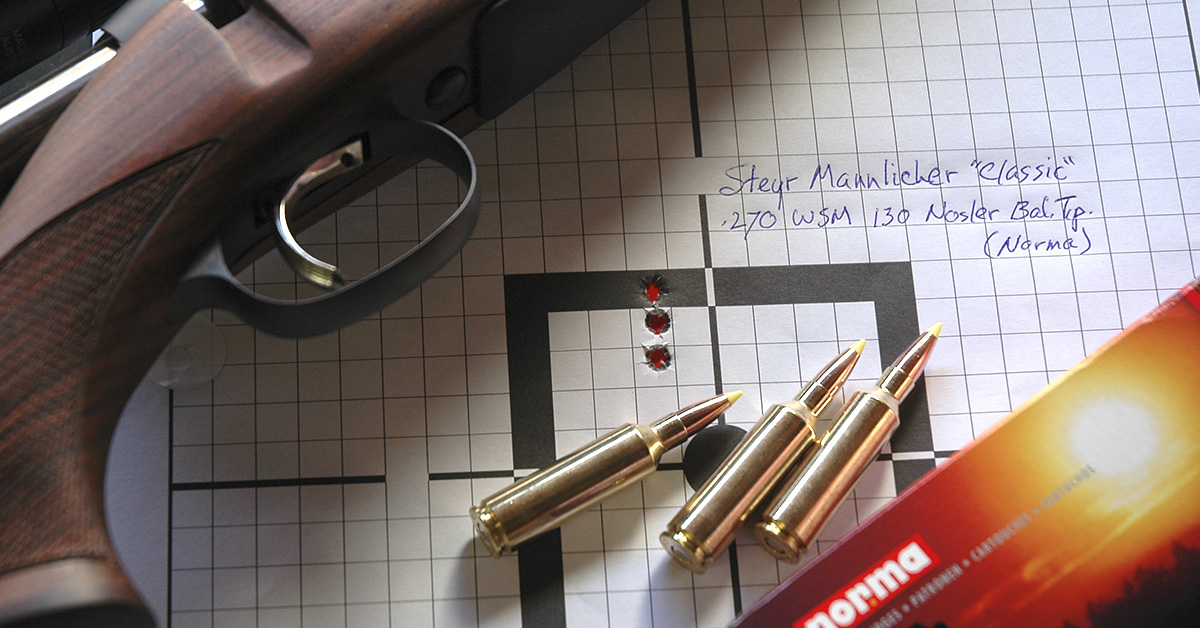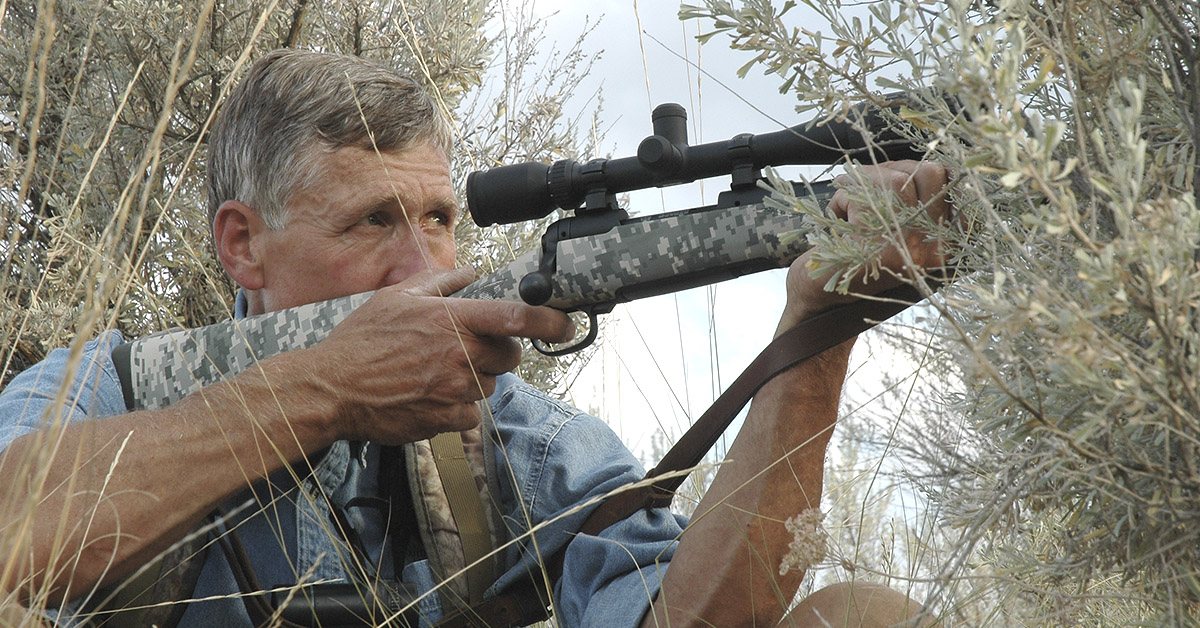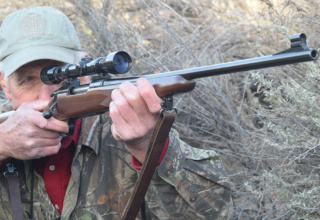An odd measure in 1925, “.270” gained traction fast. Wildcatters nursed it along. The new number: 6.8.
by Wayne van Zwoll
He had lunged up the steep, frosted basalt as if still whole and strong. Then the legs buckled. Wilting in mid-stride, he tumbled down a tongue of scree, heart-shot.
I don’t remember all shots I’ve made—or muffed—with a .270. There are too many. But that one, with an early Winchester 70 and a 2 1/2x Lyman Alaskan, first confirmed my faith in the wicked snap sending a 130-grain Sierra at Mach 3.
It’s essentially a necked-down .30-06, its 2.540-inch hull .046 longer than that of its parent. It has the same 17 ½-degree shoulder and 1.948 base-to-shoulder length. After its 1925 debut in Winchester’s Model 54, the .270 appeared in the first Model 70s, in ’37. Of 581,471 M70s built before that rifle’s ill-fated 1963 overhaul, 208,218 were .30-06s; 122,323 were .270s. In 1948, Remington announced its 721 bolt rifle in .270, with the .30-06 and .300 H&H Magnum. The .270 has since appeared in autoloaders, lever- and slide-actions, and dropping-block single-shots.
A neighbor once loaned me his Model 54 for a range session. Its bolt handle and safety had been altered for scope use. The stock had been chopped for a pad. Metal and wood showed lots of wear. Still, it sent three Power-Points into an inch. When discontinued in 1936, the Model 54 had retailed for $59.75.

Lest nostalgia tug me aside, we’d best press on to the newest .270, the 6.8 Western…
But first, the .270 Winchester’s progeny.
Wildcatters get credit for most of the few. In the 1940s, F.R. Krause of Albuquerque and Roy Triplett of Cimarron, New Mexico, re-shaped the .300 Savage over a 28-degree shoulder, set back to get a .270-length neck. Charles Evans and Bliss Titus also fashioned this cartridge, ideally suited to Savage’s 99 rifle. It’s no trick to wring 2,800 fps from 130-grain bullets.
P.O. Ackley’s .270/257 Improved has more pep. The difference between it and the 7×57 A.I. is like that between the .270 Winchester and .280 Remington: same-weight bullets .007 apart in diameter driven at nearly identical speeds. The .270/257 nips the heels of the .270 Winchester.
Rocky Gibbs squeezed as much as possible from the .30-06 case by moving the shoulder forward. The .270 Gibbs was the first of his eight wildcats, most developed after he moved from California to rural Idaho early in 1955. Rocky was proud of his loads and instructed his wife to burn his records before his death in 1973. He claimed 3,430 fps from 130-grain .270 bullets and 63 grains IMR 4350. Caveat emptor!

Ken Howell ordered up fresh brass for his .270 Howell. It’s .10 longer than the .270 Winchester’s and has a 25-degree shoulder. In my CZ rifle with a 25-inch barrel, 64 grains WMR sends 130-grain Speers at 3,256 fps. I can get 3,100 from 150-grain Noslers. One day, high in the Wallowas, I lost my footing on scree above a precipice. Hurtling down the face, I clawed for anything to brake my descent, CZ clattering over my head. My canteen tore loose, bounced into the abyss and split like a melon on rocks below. Just shy of the drop, three fingers caught a crevice. The .270, like me, came off that cliff mighty pale.
The .270 Redding, pioneered by Richard Beebe at Redding Reloading, drew my eye long before Remington came up with its similar 7mm-08. The Redding has a steeper 30-degree shoulder. My rifle has a Douglas barrel on a Remington 78 action.

One wildcatter hunched over his bench during the ’40s was Roy Weatherby. The .270 Weatherby Magnum was the first of his commercial cartridges. Based on the .300 H&H case, blown out and trimmed to 2.55 inches, it had a loaded length of 3.25, compatible with actions suiting the .270 Winchester. By 1943 standards, it reached hellish speeds: 3,375 fps with 130-grain bullets, 3,245 with 150s. Weatherby’s .270 was a charter number in his Mark V rifle in 1958. I adore this elegant round. In Montana’s Bob Marshall Wilderness, from a Mark V, it threaded 320 yards of burned timber to drop a bull elk. My E.R. Shaw rifle, on a Mauser action with Shaw barrel and Boyd’s stock, sent its first three bullets into a dime-size knot.
The next commercially viable .270 didn’t arrive until 2001. The .270 Winchester Short Magnum was in the vanguard of cartridges re-defining short. In the 1950s and ’60s, a tsunami of short belted rounds followed Weatherby’s .257, .270, and 7mm, with the .532 Holland and Holland head and roughly 2.5-inch base-to-mouth case measure. They fit actions developed for .30-06-length ammunition. The “new” short of the WSM era is about 2.100 inches. Loaded length of these fat, beltless magnums slightly exceeds the 2.8-inch standard set by the .308.

I may have shot the first elk killed with a .270 WSM. It ghosted up ahead of me as I still-hunted foggy Wyoming timber. A 70-yard poke. The .270 WSM edges the .270 Winchester by 200 fps and lags the .270 Weatherby by just over 100 fps.
Our newest .270, the 6.8 Western, doesn’t lend itself to quick comparisons because it’s designed for long, heavy bullets: 165 to 175 grains. These require quicker rifling twist than the 1-turn-in-10-inches standard for the .270 Winchester with its 130- to 150-grain bullets. The 6.8 Western case is essentially a shortened .270 WSM. The Western measures 2.020 inches, the WSM 2.100. Shoulders are 35 degrees; at .276, the 6.8’s neck is .01 longer. Maximum overall length of a 6.8 Western cartridge is 2.955, that of the WSM 2.860.

Last fall, a few Browning and Winchester rifles in 6.8 Western were loosed to pester deer and elk. Predictably cheery reports ensued. I met the 6.8 Western later, when John Krieger kindly obliged me by installing one of his accurate barrels (25 inches, 1-in-8 rifling) on a Model 70 action. I inletted a factory stock to match and added a tack-sharp 2.5-15×50 Leica Amplus 6 scope. Groups of .75 with Winchester and Browning ammunition came quickly.
You’ll find an easier route to the 6.8 Western. Winchester is offering it in nine Model 70s and 14 XPRs, all rifled 1-in-8. Browning has slated it for 21 versions of the X-Bolt, rifled 1-in-7 ½.

Factory loads for the 6.8 Western bring 18 percent more energy to 500 yards than does hunting ammo for Remington’s 7mm Magnum, with about the same recoil. The Western tops the .300 Winchester Magnum in 500-yard energy, with 16 percent less kick. The magic lies in the high ballistic coefficients of its bullets, which fight drag and wind better than do traditional .270 bullets launched faster. G1 values to .620 trump the .496 G1 b.c. of the sleek 150-grain Ballistic Silvertip in the parent .270 WSM. Leaving the muzzle at 3,120 fps, that BST races ahead of the 6.8 Western’s 165-grain Nosler AccuBond LR, ambling off at 2,970. But 500 yards on, the Western’s bullet has reeled in and passed the WSM’s.

Herewith, ballistic data for factory loads for the 6.8 Western and its important predecessors, the .270 Winchester, .270 Weatherby Magnum, and .270 WSM:
6.8 Western, Winchester165-gr. Nosler AccuBond LR
[muzzle / 100 / 200 / 300 / 400 / 500 yds]
- Velocity, fps: 2970 / 2815 / 2667 / 2524 / 2385 / 2251
- Energy, ft-lbs: 3226 / 2902/ 2605 / 2333 / 2084 / 1856
- Arc, inches: -1.5 / 1.4 / 0 /-6.3 / -18.1 /-36.0
6.8 Western, Winchester 170-gr. Ballistic Silvertip
[muzzle / 100 / 200 / 300 / 400 / 500 yds]
- Velocity, fps: 2920 / 2754 / 2593 / 2439 / 2289 / 2145
- Energy, ft-lbs: 3218 / 2862 / 2538 / 2244 / 1978 / 1736
- Arc, inches: -1.5 / 1.5 / 0 / -6.7 / -19.3 / -38.5
6.8 Western, Browning 175-gr. Sierra Pro Hunter
[muzzle / 100 / 200 / 300 / 400 / 500 yds]
- Velocity, fps: 2835 / 2686 / 2541 / 2402 / 2266 / 2135
- Energy, ft-lbs: 3123 / 2803 / 2509 / 2241 / 1995 / 1771
- Arc, inches: -1.5 / 1.7 / 0 / -7.0 / -20.1 / -40.0
.270 Winchester, Hornady 145-gr. ELD-X
[muzzle / 100 / 200 / 300 / 400 / 500 yds]
- Velocity, fps: 2970 / 2796 / 2627 / 2465 / 2308 / 2157
- Energy, ft-lbs: 2840 / 2516 / 2222 / 1955 / 1714 / 1497
- Arc, inches: -1.5 / 1.5 / 0 / -6.5 / -18.8 / -37.6
.270 Wby., Weatherby 130 Barnes TTSX
[muzzle / 100 / 200 / 300 / 400 / 500 yds]
- Velocity, fps: 3400 / 3176 / 2963 / 2761 / 2567 / 2382
- Energy, ft-lbs: 3338 / 2912 / 2536 / 2201 / 1903 / 1638
- Arc, inches: -1.5 / 1.0 / 0 / -5.0 / -14.2 / -29.3
.270 WSM, Winchester 150 gr. Ballistic Silvertip
[muzzle / 100 / 200 / 300 / 400 / 500 yds]
- Velocity, fps: 3120 / 2923 / 2734 / 2554 / 2380 / 2213
- Energy, ft-lbs: 3242 / 2845 / 2490 / 2172 / 1886 / 1631
- Arc, inches: -1.5 / 1.3 / 0 / -5.9 / -17.2 / -34.7

If you’re up to date on .270s, you’ll note the absence of two in my text. Remington’s 6.8 SPC (Special Purpose Cartridge) arrived in 2002 on the old .30 Remington case. It was designed for military use in AR 15/M16 rifles, its 115-grain bullet trumping the 55-grain .223 downrange with little loss in magazine capacity and negligible increase in recoil. I’ve killed deer with the 6.8 SPC in a Remington bolt rifle. It is all but dead as a hunting round.

The 27 Nosler, in 2020, fifth in a fleet of long belt-less magnums sparked by the 26 Nosler in 2014, arrived about the same time as the 6.8 Western. Like the 26, 28, 30, and 33 Nosler, it derives from the big .404 Jeffery hull. It holds 32 percent more powder than the .270 Winchester, 22 percent more than the .270 WSM, and 14 percent more than the .270 Weatherby. Nosler introduced it with 150-grain AccuBond bullets but has also fashioned a 165-grain AccuBond LR for it, giving Nosler Model 48 rifles sharp 1-in-8 ½ rifling to match.

Oddly enough, the 27 Nosler does not follow the current trend to shorter cases and more efficient—not faster—launches. Perhaps that trend merits another look. Later. I’m out of space.













